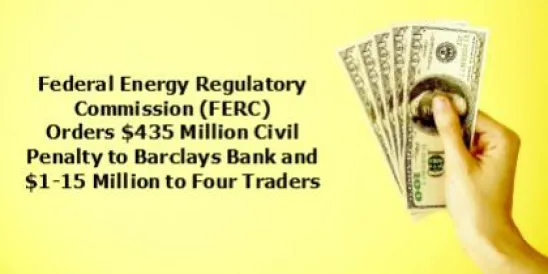On July 16, 2013, the Federal Energy Regulatory Commission ordered Barclays Bank PLC to pay one of the largest civil penalties in its history — $435 million, 144 FERC ¶ 61.041 (2013). Four traders were also assessed penalties — $15M for trader Scott Connelly, and $1M each to traders Daniel Brin, Karen Levine and Ryan Smith. The Commission also found that Barclays should disgorge $34.9M, plus interest, in unjust profits. Barclays and the traders had elected FERC procedures that require FERC to assess the penalty without formal administrative adjudication, and then pursue enforcement of its assessment in an action in federal district court. The district court action includes a de novo review of the Commission’s findings. Early reports indicate that Barclays will fight the penalty in court.
These penalties were issued after FERC found that Barclays and its traders violated the Commission’s Anti-Manipulation Rule, 18 CFR §1c.2 (2012). The Commission found that Barclays and the traders manipulated California energy markets from November 2006 to December 2008 at the four most liquid trading points in the western U.S. — Mid-Columbia, Palo Verne, North Path 15 and South Path 15, Order at 2. Specifically, the Commission found that Barclays and the traders built a “significant volume of monthly index or fixed-price physical products” at a trading point “in a direction — long or short — opposite to fixed-for-floating financial swaps they held at that point.” The Commission noted that establishing these positions “had the effect of creating physical delivery or receipt obligations which Barclays was unable to meet in actual practice,” and that Barclays and the traders were able to “flatten” these positions (“achieve zero net physical obligations”) at the end of each day through the use of next-day fixed-price or cash physical products traded on the Intercontinental Exchange platform. FERC found that the trading activity at issue was “intended to move the Index rather than respond to market fundamentals and was generally uneconomic.” Order at 4.
The Commission further concluded that Barclays and the traders not only engaged in this manipulative trading scheme, but “they did so with the intent to commit fraud.” The Commission identified seven facts found during its investigation to support its conclusions:
-
Barclays’ and the traders’ consistent pattern of building substantial positions directionally opposite their large swap positions and the subsequent flattening which would tend to move prices to benefit those swap positions;
-
how the trading behavior in the “Manipulation Months” differed from months where there was no alleged manipulation;
-
traders’ communications which discuss and describe the fraudulent scheme;
-
Barclays and the traders responding to certain allegations, but completely failing to respond to FERC Office of Enforcement staff allegations regarding the building of positions as a manipulative scheme;
-
the uneconomic nature of the trading;
-
inconsistency in trader testimony and trader explanations presented in submissions;
-
the failure of economic, statistical and legal analysis provided by Barclays and the traders to otherwise explain or defend the positions, swaps or trading.
In addition, FERC noted that it “considered various evidence to reach its conclusion concerning intent,” and provided examples of some of the compelling “speaking” evidence that it found demonstrates that the traders understood that they were making the trades to “drive price,” “protect” their positions and ”move” or “affect the Index.”
The parties have 30 days to pay the civil penalties assessed after which, the Commission can pursue enforcement of its assessment in federal district court. The parties continue to have the opportunity to settle the matter with the Commission. Absent a settlement, and unlike the DC Circuit’s decision in Hunter v. FERC, 711 F.3d 155 (D.C. Cir. 2013), this case may produce the first fully-adjudicated case on the merits of the Commission’s market manipulation theories.


 />i
/>i

